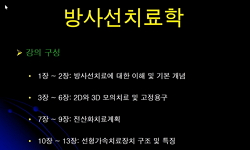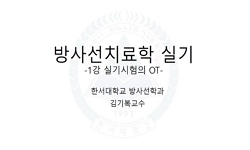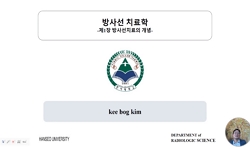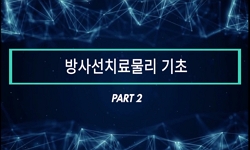목 적 : 국소진행된 III기 비소세포성 폐암에서 방사선감작제로서의 저용량 Cisplatin과 방사선 동시병합요법의 효과를 알아보고자하여, 관해율, 전체생존율, 무병생존율 및 치료에 따른 부작...
http://chineseinput.net/에서 pinyin(병음)방식으로 중국어를 변환할 수 있습니다.
변환된 중국어를 복사하여 사용하시면 됩니다.
- 中文 을 입력하시려면 zhongwen을 입력하시고 space를누르시면됩니다.
- 北京 을 입력하시려면 beijing을 입력하시고 space를 누르시면 됩니다.
https://www.riss.kr/link?id=A77004396
- 저자
- 발행기관
- 학술지명
- 권호사항
-
발행연도
1997
-
작성언어
-
- 주제어
-
KDC
510
-
등재정보
SCOPUS,KCI등재
-
자료형태
학술저널
- 발행기관 URL
-
수록면
27-36(10쪽)
- 제공처
- 소장기관
-
0
상세조회 -
0
다운로드
부가정보
국문 초록 (Abstract)
목 적 : 국소진행된 III기 비소세포성 폐암에서 방사선감작제로서의 저용량 Cisplatin과 방사선 동시병합요법의 효과를 알아보고자하여, 관해율, 전체생존율, 무병생존율 및 치료에 따른 부작용을 방사선 단독치료군과 후향적으로 비교분석하였다.
대상 및 방법 : 1992년 4월부터 1994년 3월까지 32명의 III기 비소세포성 폐암환자(IIIa 12명, IIIb 20명)가 항암제 및 방사선동시병합요법을 받았다. 방사선치료는 3000cGy/ 10회를 2주간에 걸쳐 시행한 뒤 3주후에 2500cGy/ 10회를 추가하였으며, 방사선감작제로 cis platin 6mg/m2를 매일 방사선치료 전에 정맥주사하였다. 추적관찰기간은 13개월에서 48개월로 중간값은 24개월이었다.
방사선단독치료군 32명(IIIa 13명, IIIb 19명)은 매일 170- 200cGy씩 총 5580- 7000cGy (중간값 5960cGy) 치료받았으며, 추적관찰기간은 36개월에서 105개월로 중간값은 62개월이었다.
결 과 : cis platin- 방사선동시요법군이 방사선 단독치료군에 비해 유의하게 높은완전반응률(18.8% vs . 5.6%)및 낮은 조사야내 재발율(25% vs . 47%)을 나타내었다. 2년 전체생존율은 Cisplatin- 방사선동시요법군이 17%, 방사선단독치료군이 9.4%로 유의한 차이는 보이지 않았다.국소재발 없는 2년 무병생존율(16.5% vs. 5.3%) 및 원격전이 없는 2년 무병생존율(17% vs. 4.6%)도 두군간에 유의한 차이를 보이지 않았다. 그러나 Karnofsky performance scale 80 이상인 환자군만을 대상으로 분석한 결과, cisplatin- 방사선동시요법군이 방사선단독치료군에 비해 유의하게 높은 2년 전체생존율을 보였다(62.5% vs. 15.6%). 전체생존율에 영향을 미치는 예후인자로 cisplatin- 방사선동시요법군에 있어서는 performance status 및 조직학적 진단유형(상피세포암 vs. 비상피세포암)으로 나타났고, 방사선단독치료군에 있어서는 performance status 및 병기(IIIa vs. IIIb)로 나타났다. 치료에 따른 급성부작용으로 RTOG/ECOG grade 2 이상의 오심, 구토는 cisplatin- 방사선동시요법군이 방사선단독치료군 (22% vs. 6%)에 비해 유의하게 높은 빈도를 나타내었다. Gra de 2 이상의 혈액학적 독성은 Cis platin- 방사선동시요법군에서 방사선단독치료군에 비해 높은 빈도를 나타내었다(25% vs. 15.6%). 방사선단독치료군에 비해 cis platin- 방사선동시요법군에서, RTOG/ECOG Grade 2 이상의 폐독성의 빈도(31% vs. 19%)나 WHO Grade 3 이상의 폐섬유화의 빈도(38% vs. 25%)의 유의한 증가는 관찰되지 않았다. 방사선치료부위의 면적이 200cm2 이상이었던 경우, 두군 모두에서 폐독성 빈도의 유의한 증가를 보였다.
결 론 : cisplatin- 방사선동시병합요법이 방사선단독치료군에 비해 높은 국소제어율을 나타내었으나, 전체생존율이나 무병생존율의 유의한 증가는 보이지 않았다. KPS 80이상인 환자군에 있어서는 cisplatin- 방사선동시요법군이 방사선단독군에 비해 높은 전체생존율을 보였다. cisplatin- 방사선동시병합요법군에서 급성부작용이 증가되는 경향을 보였으나, 방사선에 의한 폐독성의 유의한 증가는 관찰되지 않았다. cisplatin- 방사선동시병합요법군이 방사선단독치료군에 비해 1년 이내에 조기사망율이 높은 반면, 2년이상 장기생존율이 높은 경향을 보여, 이러한 환자군에 대한 장기적인 추적조사를 통해 생존율에 대한 본 치료의 영향을 좀더 명확하게 평가할 수 있을것으로 기대되며, 향후 치료효과를 증가시키기위해 large fraction size의 split course RT 대신 continuous course의 conventional RT 혹은 hyperfractionated RT와 Cisplatin의 동시병합요법 등이 고려되어야할 것으로 사료된다.
다국어 초록 (Multilingual Abstract)
Purpose : This study was tried to evaluate the potential be nefits of concurrent chemoradiation therapy (low dose daily cisplatin combined with split course radiation therapy) compared with conventional radiation thera py alone in stage III non- small...
Purpose : This study was tried to evaluate the potential be nefits of concurrent chemoradiation therapy (low dose daily cisplatin combined with split course radiation therapy) compared with conventional radiation thera py alone in stage III non- small cell lung cancer. The end points of analyses were responserate , overalls urvival, survival without locoregional failure , survival without distant metastasis , prognostic factors affecting survival and treatment related toxicities.
Materials and Methods : Between April 1992 and March 1994, 32 patients who had stage III non-small cell lung cancer were treated with concurrent chemoradiation therapy. Radiation therapy for 2 weeks (300cGy given 10
times up to 3000cGy) followed by a 3 weeks rest period and then radiation therapy for 2 more weeks (250cGy given 10 times up to 2500cGy) was combined with 6mg/M2 of cisplatin. Follow-up period ranged from 13 months
to 48 months with median of 24 months . Historical control group consisted of 32 patients who had stage III non-small cell lung cancer were received conventionally fractionated (daily 170- 200cGy) radiation therapy a lone. Total radiation dose ranged from 5580cGy to 7000cGy with median of 5940cGy. Follow-up period ranged from 36 months to 105 months with median of 62 months .
Results : Complete reponse rate was higher in chemoradiation therapy (CRT) group than radiation therapy (RT) group (18.8% vs. 6.3%). CRT group showed lower in-field failure rate compared with RT group(25% vs.
47%). The overall survival rate had no significant differences in between CRT group and RT group(17.5% vs. 9.4% at 2 years). The survival without locoregional failure (16.5% vs. 5.3% at 2 years) and survival without distant
metastas is (17% vs. 4.6% at 2 years) also had no significant differences . In subgroup analyses for patients with good performance status (Karnofsky performance scale 80), CRT group showed significantly higher overall
survival rate compared with RT group (62.5% vs. 15.6% at 2 years). The prognostic factors affecting survival rate were performance status and pathologic subtype (squamous cell cancer vs. nonsquamous cell cancer) in
CRT group. In RT alone group, performance status and stage (IIIa vs IIIb) were identified as a prognostic factors . RTOG/EORTC grade 2-3 nausea and vomiting(22% vs. 6%) and bone marrow toxicities (25% vs. 15.6%) were
significantly higher in CRT group compared with RT alone group. The incidence of RTOG/EORTC grade 3-4 pulmona ry toxicity had no significant differences in between CRT group and RT group (16% vs. 6%). The incidence of WHO grade 3-4 pulmonary fibrosis also had no significant differences in both group(38% vs . 25%). In analyses for relationship of field size and pulmonary toxicity, the patients who treated with field size beyond 200cm2 had s ignificantly higher rates of pulmonary toxicities.
Conclusion : The CRT group showed significantly higher local control rate than RT group. There were no significant differences of survival rate in between two groups. The subgroup of patients who had good performa nce status showed higher overall survival rate in CRT group than RT group. In spite of higher incidence of acute toxicities with concurrent chemoradiation therapy, the survival gain in subgroup of patients with good pe rformance status were encouraging. CRT group showed higher rate of early death within 1 year, higher 2 year survival rate compared with RT group. The refore, to evaluate the accurate effect on survival of concurrent chemoradiation therapy, systematic follow-up for long term survivors are needed.
동일학술지(권/호) 다른 논문
-
선량 중첩 방식을 이용한 동적 쐐기 조사면의 특성 연구
- 대한방사선종양학회
- 김미화(Mi Hwa Kim)
- 1997
- SCOPUS,KCI등재
-
전리함 반응 함수의 직접 측정과 이를 이용한 방사선의 실제선량 분포측정
- 대한방사선종양학회
- 이병용(Byong Yong Yi)
- 1997
- SCOPUS,KCI등재
-
전폐조사로 유발된 마우스의 급성폐손상에 대한 스테로이드의 효과
- 대한방사선종양학회
- 성낙관(Nak Kwan Sung)
- 1997
- SCOPUS,KCI등재
-
- 대한방사선종양학회
- 계철승(Chul Seung Kay)
- 1997
- SCOPUS,KCI등재






 ScienceON
ScienceON 스콜라
스콜라







